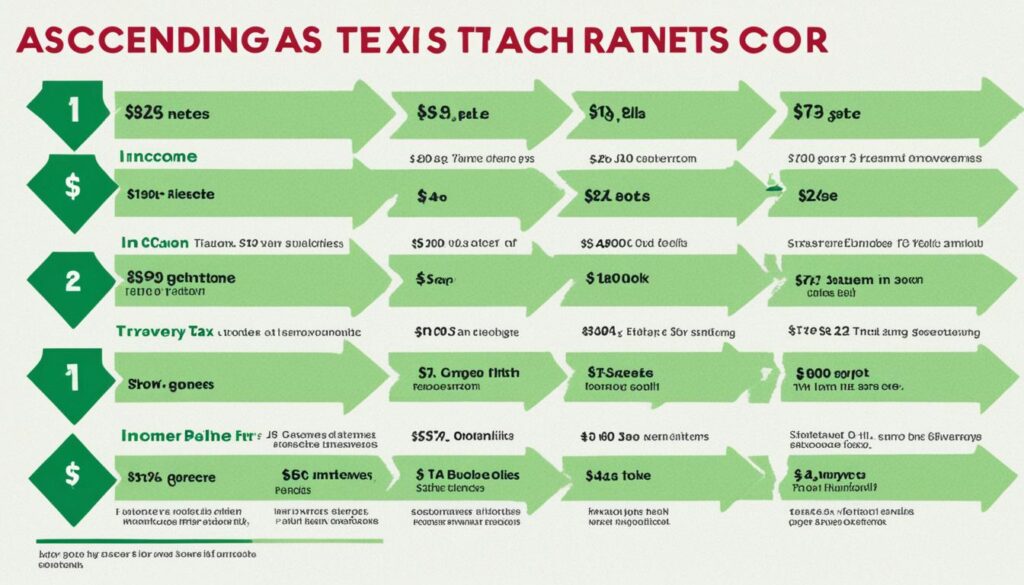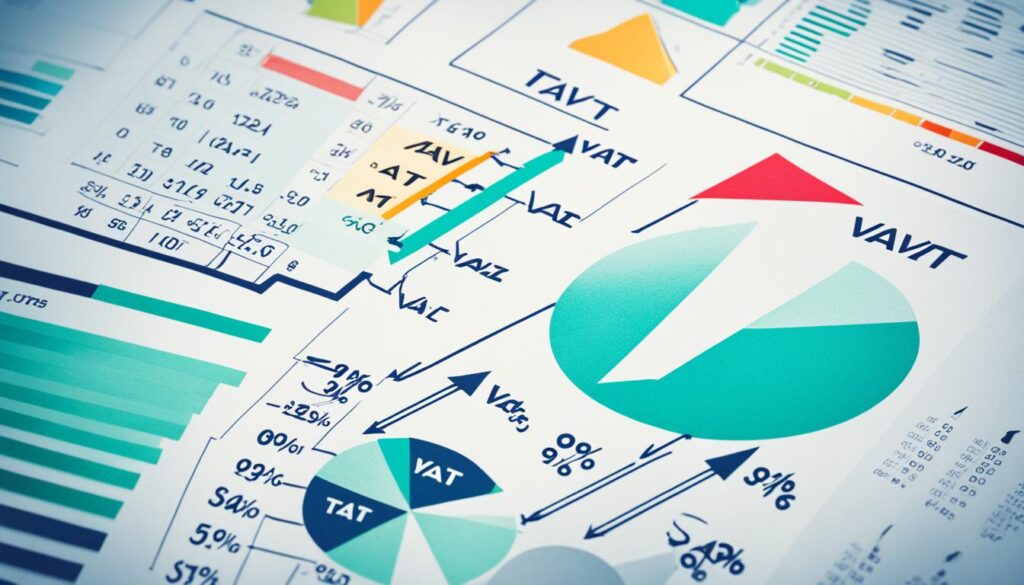Ever wondered how companies deal with the maze of taxes? How do various taxes affect what they earn? In this piece, we dive into business taxes like corporate income, self-employment, and sales taxes. We’ll look at the rules they follow and how they impact businesses.

Key Takeaways:
- Businesses face many taxes, like corporate income tax, self-employment tax, and sales tax.
- Taxes on earnings include personal and corporate income taxes, along with payroll and capital gains taxes.
- Individual income taxes change with how much you earn.
- Corporate income taxes are for C corporations. Other businesses pay through personal tax.
- Payroll taxes support programs like Social Security and Medicare.
Taxes on What You Earn
Earning money comes with various taxes. These include individual and corporate income taxes, payroll taxes, and capital gains taxes. Let’s explore each type and see how they affect your earnings.
Individual Income Taxes
Individuals or households pay individual income taxes on their earnings. These earnings could be wages, investments, or other income forms. The amount you owe depends on how much you make and IRS tax brackets.
By filing a tax return, you figure out your tax due. You can also claim deductions or credits you’re eligible for.
Corporate Income Taxes
Corporate income taxes are what businesses pay on their profits. These are applied to corporation’s earnings. The rate varies depending on how much the company makes.
Corporate taxes are crucial for funding government services. They add to the country’s total tax revenue.
Payroll Taxes
Payroll taxes come out of employee wages and fund Social Security and Medicare. These taxes appear as deductions on your paycheck. Employers also pay their share based on how much employees earn.
Capital Gains Taxes
Capital gains taxes apply to profits from selling valuable assets. This includes stocks, bonds, and real estate. How long you held the asset affects the tax rate. It’s higher for assets sold quickly.
In Summary
Knowing about different taxes on earnings is vital for managing money well. Individual and corporate income taxes, payroll taxes, and capital gains taxes are all important. Learn about these taxes and get advice from a tax advisor to make smart financial choices and meet your tax duties.
Individual Income Taxes
Understanding individual income taxes is key. The U.S. has a progressive tax system, where rates go up as income increases. Tax brackets are a big part of this system.
People with higher incomes pay more taxes. This makes the tax system fairer. It spreads the tax load more evenly.
Tax brackets split income into sections, each with its tax rate. Your income decides which rate you pay. The IRS sets these brackets and updates them yearly.
These updates are based on taxable income. They help figure out your taxes.
Now, let’s look at the 2022 tax year brackets:
| Taxable Income | Tax Rate |
|---|---|
| $0 – $9,950 | 10% |
| $9,951 – $40,525 | 12% |
| $40,526 – $86,375 | 22% |
| $86,376 – $164,925 | 24% |
| $164,926 – $209,425 | 32% |
| $209,426 – $523,600 | 35% |
| Above $523,600 | 37% |
Remember, these brackets apply after deductions and exemptions. Tax credits and deductions can lower how much tax you owe.

The aim is for wealthier people to pay more. Knowing about tax brackets helps with financial planning. Using tax strategies and deductions can reduce taxes.
Corporate Income Taxes
C corporations and passthrough businesses face different taxes. C corporations pay corporate income taxes on their profits. Passthrough businesses, like partnerships and LLCs, pass income to their owners. Then, it’s taxed as individual income.
Corporate income tax rates vary by factors like size and profit. High tax rates can affect the corporation, consumers, and employees. Prices may rise for consumers and wages could drop for employees.
“Corporate income taxes can have a broader impact beyond just the corporations themselves. Higher tax rates can result in a ripple effect, affecting consumers and employees through increased prices and reduced wages.”
The U.S. has recently cut its corporate tax rate to 21%. This aims to encourage corporations to invest more and boost the economy.
Comparing C Corporations and Passthrough Businesses
Let’s look closely at the differences between C corporations and passthrough businesses:
| C Corporations | Passthrough Businesses |
|---|---|
| C Corporations are taxed separately from their owners. | Passthrough businesses do not pay separate taxes; instead, the income is passed through to the owners and taxed at their individual tax rates. |
| C Corporations can have an unlimited number of shareholders. | Passthrough businesses are typically limited to a smaller number of owners (partners or members). |
| There is no limit on the ability to raise capital for C corporations. | Passthrough businesses may face limitations on raising capital. |
Understanding these differences helps owners make informed tax and compliance decisions. It’s wise to consult a tax professional for accurate reporting and compliance.

Payroll Taxes
Payroll taxes are essential for funding important programs like Social Security and Medicare. Both employers and employees contribute to these taxes. This helps keep these programs running for everyone.
Let’s look at the main parts of payroll taxes. We’ll see why they are important for workers and businesses.
The Social Security Tax
The Social Security tax helps fund retirement, disability, and survivor benefits. It is a key part of payroll taxes. The rate is 12.4 percent, split equally between employers and employees.
Each pays 6.2 percent. This system supports the Social Security program effectively.
The Medicare Tax
Medicare provides health insurance for those 65 and older, plus some younger people with disabilities. The Medicare tax supports this. The rate is 2.9 percent, equally divided between employer and employee.
Each contributes 1.45 percent. This funding method keeps Medicare available to those who need it.
Self-Employment Tax
If you work for yourself, you cover both parts of Social Security and Medicare taxes. This is called the self-employment tax. You pay the whole 15.3 percent that is usually shared.
This ensures self-employed people also support these necessary programs.
“Payroll taxes like Social Security and Medicare ensure financial security for retirees and access to healthcare for seniors. By contributing to these programs, workers play a vital role in supporting the well-being of our society.”
It’s vital for employees and employers to understand payroll taxes. These taxes support crucial social insurance programs. Understanding them also helps businesses manage their finances better.

Capital Gains Taxes
Capital gains taxes are key to the tax system for both businesses and individuals. These taxes apply to profits from selling capital assets like stocks, bonds, and real estate. When you sell an asset for more than you paid, you owe taxes on the gain.
These taxes greatly affect investment choices and financial planning. For individuals, knowing how selling assets impacts taxes is crucial. Businesses must factor in these taxes when making financial decisions.
The concept of double taxation is crucial in understanding capital gains taxes. This happens because corporate profits are already taxed at the corporate level. If those profits face another tax when the assets are sold, it’s called double taxation. This issue concerns economists and business leaders as it might hinder saving, investment, and growth.
Understanding double taxation and its effects is vital, despite its complexity. Both businesses and individuals should seek expert tax advice. This will help them handle capital gains taxes smartly.
Related Resources:
| Pros of Capital Gains Taxes | Cons of Capital Gains Taxes |
|---|---|
|
|

Taxes on What You Buy
Taxes aren’t just about what you make or own. They also apply to what you purchase. We pay sales taxes, gross receipts taxes, and value-added taxes on different items.
Sales taxes are placed on the sale of goods and services. Each state and locality can set its own rate, and some items may be exempt. Businesses need to know these rules where they work to stay in line with the law.
Gross receipts taxes are added to a company’s total sales, no matter if they made a profit or not. One big issue here is tax pyramiding. This happens when taxes stack up at each step of making a product, making things costlier.
Value-added taxes (VAT) are another kind. VAT is added at every step of making or selling a product. Businesses pay VAT on the value they add and get credits for taxes already paid. This helps avoid tax pyramiding, sometimes making VAT a better option.
Businesses must get how these taxes work. It’s crucial for figuring out tax costs and following the rules. Keeping good sales records, talking to tax experts, and keeping up with tax law changes are key steps.
Comparing Sales Taxes, Gross Receipts Taxes, and Value-Added Taxes
Let’s look at how these taxes differ:
| Tax Type | Application | Impact |
|---|---|---|
| Sales Taxes | Levied on retail sales of goods and services | Vary by state and locality; can influence consumer behavior and shopping decisions |
| Gross Receipts Taxes | Applied to a company’s gross sales | Potential for tax pyramiding, resulting in increased costs for businesses and higher prices for consumers |
| Value-Added Taxes (VAT) | Assessed on the value added at each production stage | Allows for the deduction of previously paid VAT, preventing tax pyramiding and promoting efficiency |
Knowing the differences helps businesses make smart choices and stay within the law.

Sales Taxes
Sales taxes are a form of tax on goods and services when sold. It’s a key way states in the U.S. make money. Most states have these taxes, except for Alaska, Delaware, Montana, New Hampshire, and Oregon.
Not all items are taxed the same. Some states don’t tax basic needs like food, medications, or cheap clothes. This keeps necessary items affordable while also making money from other sales.
In California, sales taxes don’t apply to human food, prescription meds, and certain medical devices. Texas does the same for food, medicine, and home energy.
The tax rate differs by state and sometimes within states. It’s usually a percentage of the item’s cost. This tax is collected by stores and given to the state.
Different tax rates can affect how much people buy. Higher taxes might make people spend less, while lower taxes might encourage buying.
Comparison of Sales Tax Rates in Different States
| State | Sales Tax Rate |
|---|---|
| California | 7.25% |
| Texas | 6.25% |
| New York | 4.00% |

Knowing about sales taxes, what’s taxed, and exceptions is key for everyone. It helps people make smart buying choices. For businesses, it’s vital to collect and send the right amount of tax to avoid problems. Stay informed about the tax rules in your state and get advice from a tax expert for your business.
Gross Receipts Taxes
Gross receipts taxes are placed on a company’s total sales, no matter if they made a profit. This can greatly affect businesses, including new companies and those with extended production processes.
The problem with gross receipts taxes is tax pyramiding. This happens when the tax piles up at every step of making a product. It leads to higher prices for customers.
Startups feel the weight of gross receipts taxes too. They usually have little to no profit margins. Taxes on total sales can strain their finances, blocking growth.
Businesses with long production chains face difficulties too. As taxes stack up, staying competitive gets harder. This means their products may cost more, putting them at a disadvantage.
Gross receipts taxes can fill state and local coffers. Yet, they can also hurt businesses and shoppers. Lawmakers need to think about the effects on new businesses and market fairness.

Benefits and Challenges of Gross Receipts Taxes
| Benefits | Challenges |
|---|---|
|
|
It’s key for policymakers to balance government revenue needs with business growth. Evaluating gross receipts taxes properly can lead to a stronger business climate.
Value-Added Taxes
Value-added taxes (VAT) are a type of tax on goods and services. They are added at each production stage. Many countries, including the European Union, use VAT.
VAT allows businesses to deduct taxes paid on their inputs. This prevents them from paying tax twice. Each business in the chain deducts the VAT paid before them.
The consumer ends up paying the VAT. They can’t deduct any VAT they’ve paid. VAT is included in the price consumers pay. However, how much VAT affects the price can vary.
VAT rates differ across countries and products. Some goods have lower VAT for being essential. Businesses need to know their local VAT rules and follow them.
“VAT is an important source of revenue for governments around the world. It provides a stable and predictable flow of income, which can be used to fund public services and infrastructure projects.”
Advantages of VAT
- VAT generates significant revenue for governments.
- It taxes on what people spend, not earn.
- Businesses can reduce their tax by deducting VAT on their inputs.
- It’s an efficient tax system, collected by businesses along the way.
Disadvantages of VAT
- VAT can make things more expensive for buyers.
- It’s complex for businesses to manage and follow VAT rules.
- VAT might lead to higher prices, affecting inflation.
| Country | VAT Rate |
|---|---|
| United Kingdom | 20% |
| Germany | 19% |
| France | 20% |
| Italy | 22% |
Note: The table above provides examples of VAT rates in different countries and is for illustrative purposes only.
VAT is key for government funds and fair taxation. Businesses must grasp VAT’s effect on them and follow the laws to manage taxes well.

State Taxes
Every state has its own tax rules and requirements for businesses. Understanding the taxes in your state is key for compliance and managing money. We’ll cover two main types of state taxes: state income taxes, and sales and use tax.
State Income Taxes
State income taxes are charged by states on business earnings within their borders. These are different from federal income taxes. Rates and thresholds vary, so it’s crucial for businesses to know their state’s rules.
Some states use progressive income tax systems, where tax rates go up with income. Others have a flat rate for all. Knowing your state’s tax structure helps in planning and deductions.
Sales and Use Tax
Sales and use tax is another key state tax for businesses. Sales tax applies to the sale or lease of goods and certain services. Use tax is for items bought outside the state but used within. What’s taxed and the rates can differ by state.
Businesses selling taxable items or services must collect and send sales tax to the state. This means getting a sales tax permit, charging customers, and filing returns. It’s important to know what sales are taxed and to keep sales records.
Some states give tax breaks or lower rates for certain sales or industries. Knowing these can help businesses lower their taxes and be more competitive.
State Taxes Table
| Tax Type | Description |
|---|---|
| State Income Taxes | Taxes imposed on the income earned by businesses operating within a specific state. |
| Sales and Use Tax | Tax imposed on the sale or lease of tangible personal property and certain services. |
Understanding and managing state taxes is vital for business financial obligations and compliance. Consulting a tax pro or using state online resources helps navigate state taxes well.
Local Taxes
Running a business means you must know about local taxes. Personal property taxes and local income taxes are common. These taxes are set by local governments.
Personal property taxes are charged on business assets. This includes things like equipment and vehicles. The tax rates change depending on where you are. It’s assessed every year, so knowing local rules is key.
Local income taxes may also apply. This is on top of state and federal taxes. Rates and rules for these taxes can differ. Check with your local authorities for details.
To avoid tax issues, learn about taxes in your area. Contact your county government or municipality for info on taxes. Being informed helps you avoid fines and stay compliant.